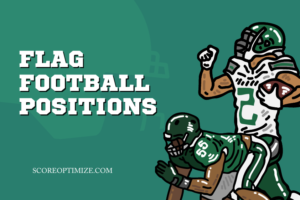The Essential Guide to Flag Football Rules Understanding the Game
Are you ready to dive into the thrilling world of flag football? Whether you’re a curious spectator or an
aspiring player, understanding the rules of this fast-paced sport is essential for fully appreciating its
excitement and strategy.
Flag football offers all the fun and competitiveness of traditional football, but with a unique twist that
makes it accessible to players of all ages and skill levels. No tackling required! Instead, players use flags
attached to their waists, creating a game that’s both safer and more inclusive. But don’t be fooled – flag
football is far from simple. Its intricate rules and strategies can leave newcomers feeling overwhelmed
and confused.
In this comprehensive guide, we’ll break down everything you need to know about flag football rules.
From the basic concepts to advanced tactics, we’ll cover it all. By the time you finish reading, you’ll be
well-equipped to join in the fun or become a more informed spectator. So, are you ready to unlock the
secrets of flag football? Let’s get started!
Basic Concepts of Flag Football
As we delve into the world of flag football, it’s essential to understand the fundamental concepts that form the backbone of this exciting sport. Flag football offers a safer, non-contact alternative to traditional American football while maintaining the thrill and strategy of the game. Let’s explore the basic elements that make flag football unique and engaging.

A. Objective of the Game
The primary objective of flag football is similar to traditional football: score more points than the opposing team. However, the way this is achieved differs significantly. In flag football, players aim to advance the ball down the field and cross the goal line without having their flags pulled by the opposing team.
Key points about the objective:
- Scoring: Teams score points by reaching the end zone with the ball.
- Flag pulling: Instead of tackling, defenders remove flags from the ball carrier to stop their progress.
- Time management: Teams must efficiently use their allotted time to outscore their opponents.
- Strategic play: Both offense and defense must employ tactics to either advance the ball or prevent advancement.
The non-contact nature of flag football makes it an inclusive sport, suitable for players of various ages, genders, and skill levels. This accessibility contributes to its growing popularity in schools, recreational leagues, and even professional circuits.
B. Equipment Needed
Flag football requires minimal equipment compared to its full-contact counterpart, making it more accessible and cost-effective. Here’s a comprehensive list of essential equipment for flag football:
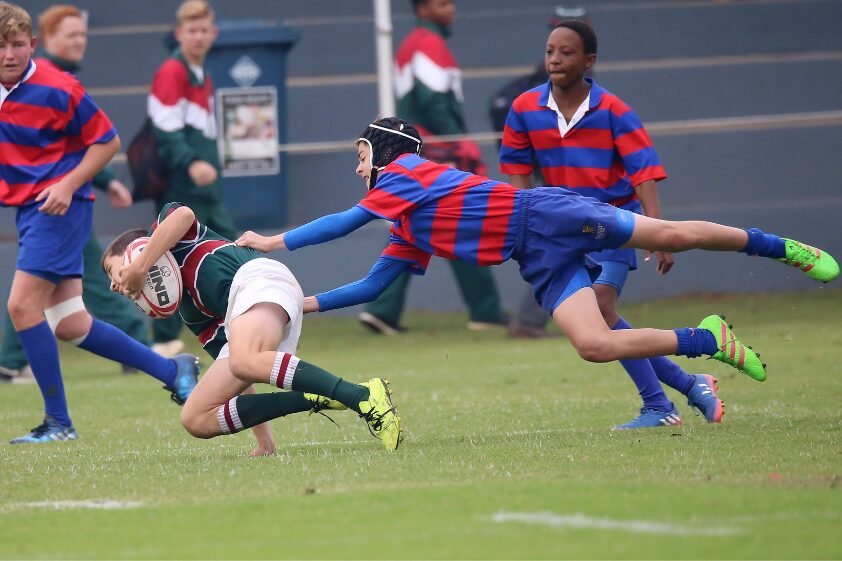
- Flags and Flag Belts
- Each player wears a belt with two or three flags attached.
- Flags are typically 14-20 inches long and 2 inches wide.
- Colors should contrast with the players’ uniforms for visibility.
- Football
- A regulation-size football is used for adult leagues.
- Youth leagues may use smaller footballs appropriate for their age group.
- Uniforms
- Jerseys or shirts with numbers for player identification.
- Shorts or pants without pockets (to prevent flag-pulling interference).
- Cleats for better traction (metal cleats are usually prohibited).
- Field Markers
- Cones or pylons to mark field boundaries and end zones.
- Yard markers for tracking field position.
- Optional Equipment
- Mouthguards for additional safety.
- Gloves to improve grip on the ball.
- Athletic tape for finger protection.
Here’s a comparison table of equipment needed for flag football versus traditional football:
| Equipment | Flag Football | Traditional Football |
| Flags/Flag Belts | Required | Not Used |
| Football | Required | Required |
| Jerseys | Required | Required |
| Pants/Shorts | Required | Required |
| Cleats | Recommended | Required |
| Helmets | Not Used | Required |
| Shoulder Pads | Not Used | Required |
| Field Markers | Required | Required |
| Mouthguards | Optional | Required |
| Gloves | Optional | Optional |
The simplicity of equipment in flag football contributes to its accessibility and safety, making it an
attractive option for players of all skill levels.
C. Team Composition and Positions
Flag football teams typically consist of fewer players on the field compared to traditional football, allowing
for a more dynamic and fast-paced game. The team composition and positions can vary depending on
the specific league or tournament rules, but here’s a general overview:
Team Size
- Most common: 5-on-5 or 7-on-7 formats
- Some leagues use 8-on-8 or 9-on-9 formats
- Roster sizes are usually larger to allow for substitutions
- Quarterback (QB): Leads the offense and typically passes the ball
- Center: Snaps the ball to the quarterback
- Receivers: Run routes and catch passes
- Running Backs: Receive handoffs and catch short passes
Defensive Positions
- Rushers: Attempt to pressure the quarterback
- Defensive Backs: Cover receivers and attempt to intercept passes
- Linebackers: Versatile players who can rush or cover
Specialized Positions (in some formats)
- Kicker: For leagues that allow field goals or extra point kicks
- Punter: For leagues that incorporate punting
Key differences in team composition compared to traditional football:
- No Linemen: Flag football doesn’t typically use offensive or defensive linemen due to its noncontact nature.
- Versatility: Players often need to be more versatile, playing multiple positions on both offense and
defense. - Continuous Play: With smaller teams, players often stay on the field for both offense and defense,
requiring well-rounded skills and endurance
Let’s break down the responsibilities of key positions in flag football:
- Primary passer and offensive leader
- Reads the defense and makes play decisions
- May run with the ball if allowed by league rules

Receivers
- Run predetermined routes to get open
- Catch passes from the quarterback
- Block for teammates on running plays (if allowed)
Running Backs
- Receive handoffs for rushing plays
- Serve as check-down receivers for short passes
- Block for the quarterback on passing plays
Rushers
- Attempt to pressure the quarterback
- Must start at least 7 yards from the line of scrimmage
- Time their rush to coincide with the snap
Defensive Backs
- Cover receivers in man-to-man or zone coverage
- Attempt to deflect or intercept passes
- Pull flags of offensive players who catch the ball
The flexibility in positions allows players to showcase a wide range of skills and adapt to different roles
throughout the game. This versatility is one of the aspects that makes flag football an engaging and
dynamic sport for participants.
D. Field Layout and Dimensions
The field layout in flag football is similar to traditional football but with some key differences to accommodate the unique aspects of the game. Understanding the field dimensions and layout is crucial for players, coaches, and spectators alike.
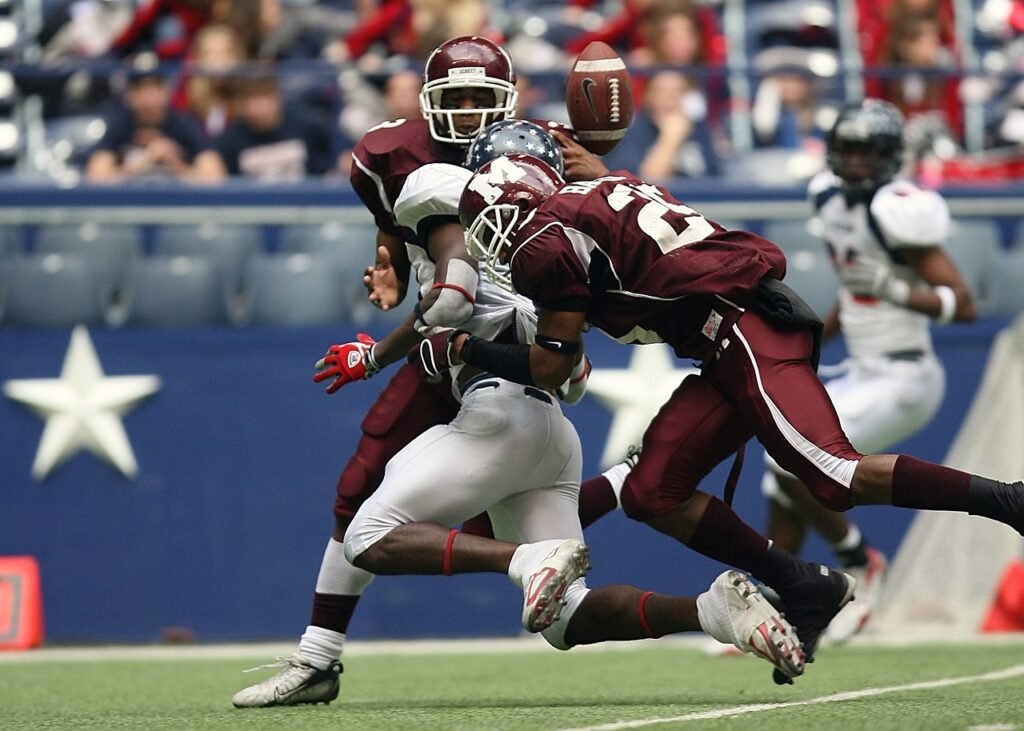
Standard Flag Football Field Dimensions:
- Length: 70-80 yards (plus end zones)
- Width: 30 yards
- End Zones: 10 yards deep at each end
- Total Playing Area: 90-100 yards long by 30 yards wide
Key Elements of the Field Layout:
- Line of Scrimmage: Where the play begins, marked by the football’s position
- First Down Markers: Usually set at 20-yard intervals
- No-Running Zones: 5-yard areas before each end zone (in some leagues)
- End Zones: 10-yard scoring areas at each end of the field
Let’s dive deeper into each aspect of the field layout:
Field Length and Width
The standard flag football field is shorter and narrower than a traditional football field. This compact size allows for faster-paced play and is more suitable for the smaller team sizes in flag football. The reduced width also encourages more vertical passing routes and quicker sideline plays.
End Zones
The end zones in flag football are typically 10 yards deep, the same as in traditional football. These areas are crucial for scoring touchdowns and are often the focal point of offensive strategies.
First Down Markers
Unlike traditional football, which uses 10-yard intervals for first downs, flag football often employs 20-yard intervals. This change accommodates the shorter field length and encourages more aggressive offensive play. Some leagues may use different intervals, such as 15 yards or even maintain the traditional 10-yard system.
No-Running Zones
Many flag football leagues implement “no-running zones” near the end zones. These are typically 5-yard areas where the offense must attempt a pass play rather than a run. This rule adds an extra layer of strategy and prevents teams from simply running the ball in for short-yardage touchdowns.
Line of Scrimmage
The line of scrimmage functions similarly to traditional football, marking where each play begins. However, in flag football, there are often restrictions on how close defensive players can line up to this line, typically requiring a 7-yard cushion for rushers.
Here’s a visual representation of a typical flag football field layout:

Field Markings:
- Sidelines: Clearly marked boundaries on both sides of the field
- Goal Lines: Marking the beginning of each end zone
- Midfield Line: Dividing the field into two equal halves
- First Down Markers: Usually at 20-yard intervals
- No-Running Zone Markers: 5 yards before each end zone (if applicable)
Adaptations for Different Formats:
- Youth Leagues: May use smaller field dimensions to suit younger players
- Indoor Leagues: Often use modified dimensions based on available space
- Recreational Leagues: Might use existing soccer or other sports fields with temporary markings
Understanding the field layout is crucial for several reasons:
- Strategic Planning: Coaches and players can design plays that take advantage of the field dimensions.
- Spatial Awareness: Players need to know boundaries and markers for effective gameplay.
- Rule Compliance: Many rules in flag football are tied to specific areas of the field.
- Game Management: Officials use field markings to make accurate calls and manage the game effectively.
The unique field layout of flag football contributes significantly to the sport’s fast-paced and exciting nature. It encourages creative play-calling, rewards agility and speed, and creates an environment where both offense and defense have ample opportunities to make game-changing plays.
As we’ve explored the basic concepts of flag football, including the objective, equipment, team composition, and field layout, we’ve laid a solid foundation for understanding this dynamic sport. These elements work together to create a game that’s accessible, exciting, and strategically rich. With this knowledge, players and fans alike can better appreciate the nuances of flag football and the skills required to excel in this increasingly popular sport.
Now that we have covered the fundamental aspects of flag football, we can move on to explore the intricacies of gameplay and scoring, which build upon these basic concepts to create the thrilling matches that make flag football so engaging.
Gameplay and Scoring
As we delve deeper into the world of flag football, it’s crucial to understand the fundamental aspects of
gameplay and scoring. This knowledge forms the backbone of any player’s or spectator’s
comprehension of the sport. Let’s explore the key elements that make flag football an exciting and
dynamic game.
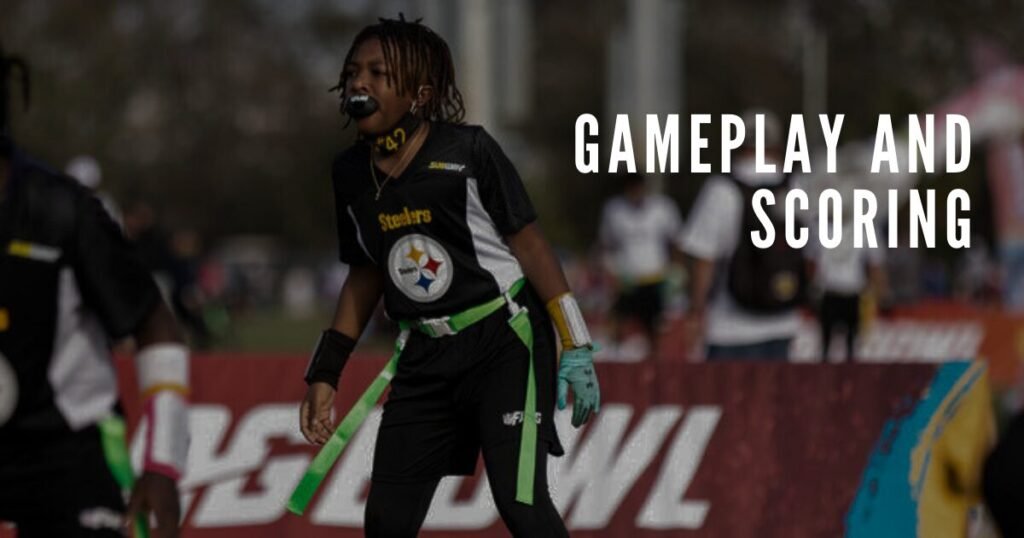
A. Time Limits and Periods
Flag football games are typically structured into distinct periods, each with its own time limits. This
structure ensures a fair and organized match while maintaining the fast-paced nature of the sport.
Standard Game Duration
Most flag football games consist of two 20-minute halves, with a brief halftime break in between.
However, the exact duration can vary depending on the league or tournament rules. Some variations
include:
- Four 12-minute quarters
- Two 25-minute halves
- Running clock vs. stopped clock
Running Clock vs. Stopped Clock
In many recreational leagues, a running clock is used to keep the game moving swiftly. This means the
clock continues to run even when the ball is out of bounds or incomplete passes occur. However, in
more competitive settings or during the last two minutes of each half, a stopped clock may be employed.
This allows for more strategic play and potential comebacks.
Time-outs
Teams are typically allotted a certain number of time-outs per half. These brief pauses in play (usually 60
seconds) allow teams to regroup, discuss strategy, or catch their breath. The strategic use of time-outs
can be crucial in close games.
| Huddle Type | Advantages | Disadvantages |
|---|---|---|
| Traditional Huddle | Clear communication, time to strategize | Takes more time, allows defense to set up |
| No-Huddle | Keeps defense off-balance, faster pace | Potential for miscommunication, less time to adjust plays |
Play Clock
To maintain the game’s pace, a play clock is often implemented. This gives the offense a set amount of
time (usually 25-30 seconds) to start their next play. Failure to snap the ball within this time frame results
in a delay of game penalty.
B. Point Values for Different Scoring Plays
Flag football offers various ways to score points, each with its own point value. Understanding these
values is crucial for both offensive strategy and defensive priorities.
Touchdown: 6 points
- The primary scoring method in flag football.
- Achieved when a player carries the ball across the opponent’s goal line or catches a pass in the end zone
Extra Point Conversion:
- 1 point: Scored from the 5-yard line
- 2 points: Scored from the 10-yard line
- Some leagues offer a 3-point conversion from the 20-yard line
Safety: 2 points
- Awarded to the defensive team when they tackle an offensive player in their own end zone
- Also awarded if the offense commits a foul in their own end zone
Defensive Score: 6 points + extra point attempt
- When the defense intercepts a pass or recovers a fumble and returns it to the end zone
C. Scoring Methods
Now that we’ve covered the point values, let’s dive deeper into the various methods of scoring in flag
football.

- Touchdowns
Touchdowns are the primary means of scoring in flag football. They can be achieved in several ways:
- Running Play: A player carries the ball across the opponent’s goal line
- Passing Play: A receiver catches a pass while in the end zone
- Defensive Return: An intercepted pass or recovered fumble is returned to the end zone
To score a touchdown, the ball carrier must have at least one foot in the end zone when their flag is
pulled or when they cross the goal line. The ball’s position is crucial – it must break the plane of the goal
line for a touchdown to be awarded.
- Extra Point Conversions
After scoring a touchdown, teams have the opportunity to add extra points through a conversion attempt.
Unlike traditional football, there’s no kicking involved. Instead, teams run an offensive play from a
predetermined yard line:
- 1-point conversion: Attempted from the 5-yard line
- 2-point conversion: Attempted from the 10-yard line
- 3-point conversion: Some leagues offer this option from the 20-yard line
The team can choose which conversion to attempt based on their offensive strengths and the game
situation. A successful conversion occurs when the offense completes a pass or run into the end zone
from the chosen yard line.
- Safeties
Safeties occur when the defensive team tackles an offensive player in their own end zone or when the
offense commits a foul in their own end zone. This results in 2 points for the defensive team and
possession of the ball.
Common scenarios leading to safeties include:
- A ball carrier’s flag is pulled in their own end zone
- An offensive player steps out of bounds in their own end zone
- The quarterback is flagged for intentional grounding while in the end zone
- Defensive Scoring
In flag football, the defense can directly score points by returning an interception or fumble recovery to
the opponent’s end zone. This results in 6 points, plus the opportunity for an extra point conversion.
Defensive scoring adds an exciting element to the game, as it can lead to sudden momentum shifts and
dramatic comebacks.
D. Downs and First Downs
The concept of downs in flag football is similar to traditional football but with some key differences.
Understanding this system is crucial for both offensive and defensive strategies.
Four-Down System
Flag football typically uses a four-down system. The offensive team has four attempts (downs) to
advance the ball 10 yards or more. If they succeed, they earn a new set of downs. If they fail, they must
turn the ball over to the opposing team.
First Downs
A first down is achieved when the offense successfully advances the ball 10 yards or more within their
four downs. This resets the down count, giving the offense a fresh set of four downs to continue their
drive.
Ways to earn a first down include:
- Running plays that gain 10+ yards cumulatively over multiple downs
- Completing a pass that gains 10+ yards
- Defensive penalties that result in automatic first downs
Measuring for First Downs
In many flag football leagues, especially at recreational levels, first downs are often estimated visually by
the officials. However, in more competitive settings, markers or chains may be used to precisely
measure close calls.
No-Run Zones
A unique aspect of flag football is the “no-run zone.” This is typically a 5-yard area before each goal line
and before the line to gain a first down. Within these zones, the offense must attempt a forward pass –
running plays are not allowed. This rule adds strategy and prevents teams from relying solely on short
running plays in crucial situations.
Turnover on Downs
If a team fails to gain a first down after their four attempts, it results in a turnover on downs. The ball is
then given to the opposing team at the spot where the fourth down play ended.
E. Starting the Game
The process of starting a flag football game sets the tone for fair play and establishes initial field position.
Let’s explore the key elements involved in kicking off a flag football match.
- Coin Toss
Before the game begins, a coin toss is conducted with team captains to determine which team will start
with possession. The winning team typically has two options:
- Choose to start on offense or defense
- Choose which end of the field to defend
The losing team then gets to make the remaining choice. This process ensures fairness in the initial
game setup
- Starting Positions
Unlike traditional football, flag football doesn’t typically involve kickoffs. Instead, the game starts with the
offensive team taking possession at a predetermined spot on the field. Common starting positions
include:
- The 5-yard line
- The 10-yard line
- The 20-yard line (similar to a touchback in traditional football)
The exact starting position can vary based on league rules or field size.
- Second Half Start
At the beginning of the second half, the team that started on defense in the first half typically gets to start
on offense. This alternating possession helps maintain fairness throughout the game. - After Scoring Plays
Following a touchdown and extra point attempt, the scoring team does not kick off. Instead, the opposing
team takes possession at their designated starting yard line. This rule keeps the game moving quickly
and eliminates the need for special teams plays. - Safety Procedures
If a safety occurs, the team that scored the safety receives two points and gets possession of the ball.
They typically start their drive from their own designated starting yard line. - Pre-Game Preparations
Before the game officially starts, teams often engage in:
- Warm-up exercises
- Equipment checks (ensuring flags are properly attached)
- Brief team huddles or strategy discussions
Officials may also conduct a brief meeting with team captains to review key rules or any specific league
regulations.
By understanding these fundamental aspects of gameplay and scoring in flag football, players and
spectators alike can fully appreciate the strategy and excitement of the sport. From the fast-paced nature
of timed periods to the various scoring opportunities and the unique down system, flag football offers a
dynamic and engaging experience for all involved. As we move forward, we’ll explore the specific rules
and strategies that shape offensive play, providing even deeper insight into this exciting sport.
Offensive Flag football Rules and Strategies
Now that we’ve covered the basics of gameplay and scoring in flag football, let’s dive into the offensive
rules and strategies that can help your team move the ball down the field and score points.
Understanding these rules and implementing effective strategies is crucial for success in flag football.

A. Play Clock and Huddles
In flag football, the play clock is an essential element that keeps the game moving at a brisk pace. Unlike
traditional football, flag football typically employs a shorter play clock to maintain a fast-paced, exciting
game.
Play Clock Basics
- Most flag football leagues use a 25-second play clock.
- The clock starts when the official signals the ball is ready for play.
- Teams must snap the ball before the play clock expires to avoid a delay of game penalty.
Huddle Strategies
Huddles in flag football serve the same purpose as in traditional football: to communicate the next play to
the team. However, due to the shorter play clock, teams must be efficient in their huddle process.
- Quick Communication: Quarterbacks should relay play calls quickly and clearly.
- Hand Signals: Develop a system of hand signals for no-huddle situations.
- Audibles: Practice calling audibles at the line of scrimmage to adjust to defensive formations.
No-Huddle Offense
Many flag football teams opt for a no-huddle offense to keep the defense off-balance and maintain a fast
tempo. This strategy can be particularly effective when:
- The defense is struggling to substitute players
- You want to prevent the defense from making adjustments
- You’re trying to score quickly before the end of a half or game
B. Offensive Formations
Offensive formations in flag football are designed to create mismatches and open spaces for receivers.
While there are numerous formations to choose from, here are some of the most common and effective
ones:
Spread Formation
The spread formation is a staple in flag football due to its versatility and ability to stretch the defense
horizontally
- Typically uses 3-4 receivers spread across the line of scrimmage
- Creates one-on-one matchups for receivers
- Allows for quick passes and screen plays
Trips Formation
The trips formation overloads one side of the field with three receivers, creating confusion for the
defense.
- Three receivers on one side, one receiver on the opposite side
- Forces the defense to decide whether to overcommit to the trips side
- Creates opportunities for isolation plays on the single-receiver side
Diamond Formation
The diamond formation places receivers in a diamond shape around the quarterback, offering multiple
quick passing options.
- One receiver behind the quarterback, two on either side, one in front
- Excellent for screen passes and short, quick throws
- Provides good protection for the quarterback
Empty Backfield
An empty backfield formation spreads all eligible receivers across the line of scrimmage, leaving no
players in the backfield except the quarterback.
- Maximizes passing options
- Forces the defense to declare their coverage
- Can be vulnerable to blitzes
Here’s a comparison of these formations:
| Spread | Versatile, creates space | Can leave QB vulnerable |
| Trips | Overloads one side, creates mismatches | Predictable direction of play |
| Diamond | Multiple quick options, QB protection | Limited deep threats |
| Empty | Backfield Maximizes receivers, forces defensive declaration | No running threat, vulnerable to blitz |
C. Running with the Ball
While flag football is primarily a passing game, effective running plays can keep the defense honest and
provide a change of pace. Understanding the rules and strategies for running with the ball is crucial for a
well-rounded offense.

Rules for Running Plays
- No Diving: Players are not allowed to dive or jump to advance the ball or avoid a flag pull.
- Flag Guarding: Runners cannot use their hands or arms to prevent defenders from pulling their
flags. - Spinning: Most leagues allow spinning, but excessive spinning may be penalized.
- Stiff-Arming: Stiff-arming is generally not allowed in flag football.
Effective Running Strategies
- Misdirection Plays: Use fake handoffs and reverses to confuse the defense.
- Draw Plays: Fake a pass to draw defenders away, then hand off to a runner.
- Option Plays: Give the quarterback the option to run or pass based on the defense’s reaction.
- Screen Passes: While technically a pass, screen plays often function like running plays.
Tips for Ball Carriers
- Keep the ball tucked securely to avoid fumbles.
- Use quick, lateral movements to avoid flag pulls.
- Be aware of the first down marker and try to gain necessary yardage.
- Look for cutback lanes if the initial path is blocked.
Importance of Blocking in the Running Game
While traditional blocking is not allowed in flag football, players can still use their bodies to obstruct
defenders without making physical contact. This is often referred to as “screening” or “shielding.”
- Offensive players can position themselves between defenders and the ball carrier.
- Blockers should keep their hands behind their backs to avoid holding penalties.
- Effective blocking can create running lanes and extend plays.
D. Passing and Receiving
Passing and receiving are the cornerstones of flag football offense. Mastering these skills and
understanding the related rules is essential for success on the field.
Passing Rules
- Forward Pass: Only one forward pass is allowed per down, and it must be thrown from behind the
line of scrimmage. - Backward Pass: Lateral or backward passes are allowed at any time.
- Pass Rush: Defenders must wait for a designated count (usually 5-7 seconds) before rushing the
quarterback. - Interceptions: Defenders can intercept passes and return them
Quarterback Strategies
- Read Progressions: Develop a system of reading receivers in a specific order.
- Look Off Defenders: Use your eyes to manipulate defenders and create openings.
- Timing Routes: Practice timing with receivers to hit them in stride.
- Scramble Rules: Establish predetermined routes for receivers when the quarterback scrambles.
Receiving Techniques
- Proper Hand Positioning: Form a diamond with your hands to catch the ball.
- Body Catching: Avoid relying on body catches; use your hands.
- Sideline Awareness: Practice toe-tapping to stay inbounds on sideline catches.
- Route Running: Master crisp cuts and changes of direction to create separation.
Advanced Passing Concepts
- Option Routes: Allow receivers to adjust their routes based on the defense.
- Hot Routes: Designate quick passes to beat blitzes.
- Zone Beaters: Design plays to exploit gaps in zone coverage.
- Man Beaters: Use picks and rubs (within the rules) to defeat man-to-man coverage.
Here’s a table comparing different types of passing plays:
| Pass Type | Description | Best Used Against |
|---|---|---|
| Quick Slant | Short, diagonal route across the middle | Man coverage, Blitzes |
| Out Route | Receiver runs toward sideline | Zone coverage |
| Post Route | Diagonal route toward the middle of the field | Single-high safety |
| Corner Route | Diagonal route toward the sideline | Two-high safety look |
| Screen Pass | Short pass behind the line of scrimmage | Aggressive pass rush |
Importance of Chemistry Between Quarterback and Receivers
Developing strong chemistry between the quarterback and receivers is crucial for a successful passing
game. This involves:
- Practice: Spend extra time working on timing and route precision.
- Non-Verbal Communication: Develop a system of hand signals and body language.
- Trust: Quarterbacks must trust receivers to be in the right spot at the right time.
- Adjustments: Both quarterbacks and receivers should be able to adjust to defensive changes.
Strategies for Different Field Positions
The passing game should adapt based on field position:
- Red Zone (Inside the 20-yard line):
Use shorter, quicker passes
Look for mismatches with bigger receivers
Implement fade routes to the corners of the end zone - Mid-Field:
Mix up short and long passes
Use the full width of the field
Implement crossing routes to create confusion - Backed Up (Near Your Own End Zone):
Focus on quick, high-percentage passes
Use play-action to create big play opportunities
Be cautious of interceptions that could result in easy defensive touchdowns
Adapting to Weather Conditions
Weather can significantly impact the passing game. Here are some strategies for different conditions:
- Wind:
Adjust throwing mechanics for accuracy
Use more running plays and short passes
Take advantage of the wind when it’s at your back - Rain:
Use gloves for better grip (if allowed)
Rely more on running plays and short passes
Be extra careful with ball security - Extreme Heat:
Use more no-huddle to tire out the defense
Rotate players more frequently to prevent fatigue
Stay hydrated to maintain focus and accuracy
By mastering these offensive rules and strategies, your flag football team will be well-equipped to move
the ball efficiently and score points consistently. Remember, the key to success in flag football is a
balanced attack that keeps the defense guessing. Utilize a mix of running and passing plays, vary your
formations, and always be prepared to adapt to the defense’s adjustments. With practice and
experience, your team can become a formidable offensive force on the flag football field.
Now that we’ve covered offensive strategies, let’s move on to examine the defensive rules and tactics
that teams use to stop their opponents and regain possession of the ball.
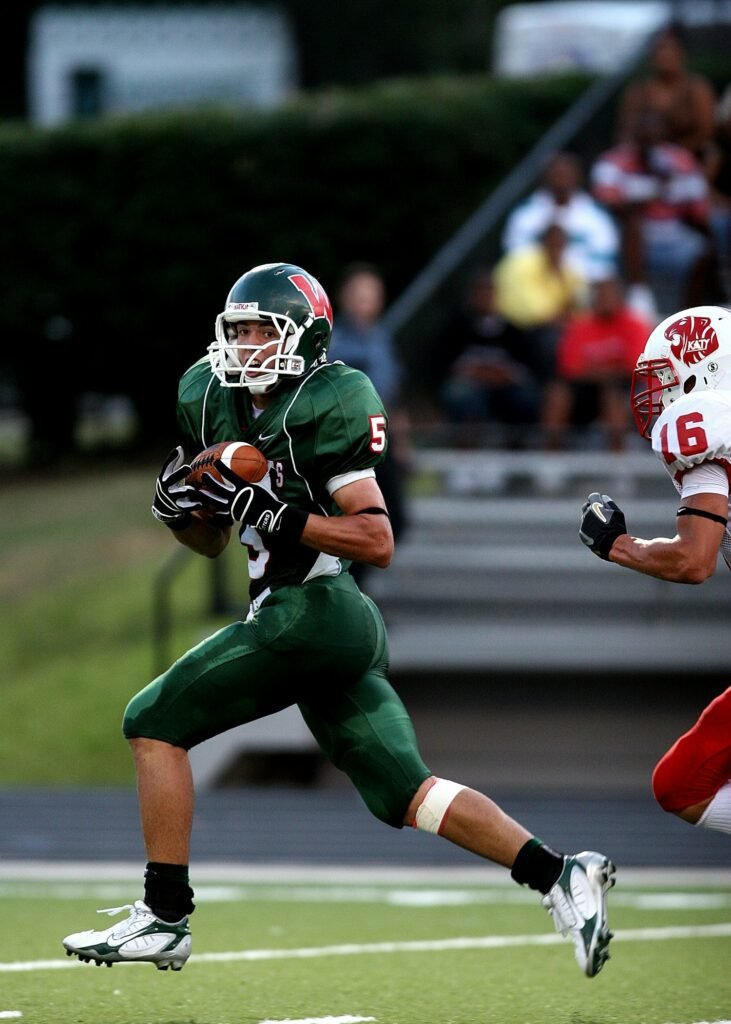
Conclusion
Flag football is an exciting, inclusive sport that combines the strategy and intensity of traditional football with a non-contact approach, making it accessible to a wider range of players. Understanding the essential rules and strategies is crucial for both players and spectators to fully appreciate the game’s nuances and thrills.
From the basic concepts like the objective of the game, necessary equipment, and team composition to more intricate details like gameplay rules, scoring methods, and offensive strategies, this guide provides a comprehensive overview to help you get started. Whether you’re aiming to join a team, improve your skills, or simply enjoy the game as a fan, knowledge of these fundamentals will enhance your experience.
So, are you ready to embrace the world of flag football? Grab your flags, hit the field, and enjoy the fast-paced, strategic fun that this sport has to offer!


